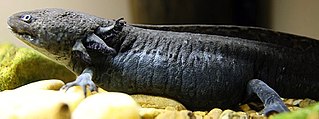
The axolotl is a paedomorphic salamander closely related to the tiger salamander. It is unusual among amphibians in that it reaches adulthood without undergoing metamorphosis. Instead of taking to the land, adults remain aquatic and gilled. The species was originally found in several lakes underlying what is now Mexico City, such as Lake Xochimilco and Lake Chalco. These lakes were drained by Spanish settlers after the conquest of the Aztec Empire, leading to the destruction of much of the axolotl's natural habitat.
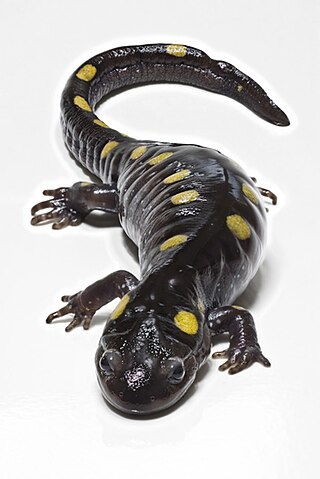
The mole salamanders are a group of advanced salamanders endemic to North America. The group has become famous due to the presence of the axolotl, widely used in research due to its paedomorphosis, and the tiger salamander which is the official amphibian of many US states, and often sold as a pet.

The tiger salamander is a species of mole salamander and one of the largest terrestrial salamanders in North America.

The Lake Patzcuaro salamander, locally known as achoque, is a paedomorphic species of salamander found exclusively in Lake Pátzcuaro, a high-altitude lake in the Mexican state of Michoacán. First described in 1870 by Alfredo Dugès, the species is named in honor of the French herpetologist Auguste Duméril. However, the salamander has been used as a food source and an ingredient in traditional medicines by the Purépecha people since the Pre-Columbian era. Ambystoma dumerilii are neotenic, meaning they retain their larval characteristics throughout their entire life. This results in adults that have long, heavily filamented external gills, gill slits lined with tooth-like gill rakers, and caudal fins. When stressed, Ambystoma dumerilii can undergo an incomplete metamorphosis, though this is process significantly decreases their lifespan and is often fatal.
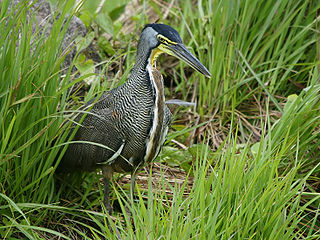
The bare-throated tiger heron is a wading bird of the heron family, Ardeidae, found from Mexico to northwestern Colombia, with one recorded sighting from the United States in Hidalgo County, Texas. It is 80 cm (31 in) in length and weighs 1,200 g (42 oz).
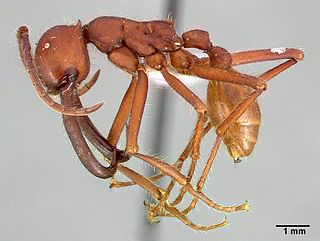
Eciton mexicanum is a species of New World army ant in the genus Eciton. Present from Mexico to throughout Costa Rica and northern Argentina, it is found in dry and wet forests in sea level to montane areas. Raids always occur in columns, tending to be usually nocturnal but are sometimes also encountered during the day. It is closely related to the Eciton burchellii species.

Hedyosmum mexicanum is a species of plant in the family Chloranthaceae. It is found in Guatemala and Mexico. It is threatened by habitat loss.
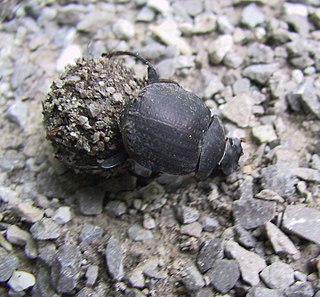
Deltochilum is a genus of true dung beetles in the family Scarabaeidae native to the Americas. There are more than 100 described species in Deltochilum. Unusually for a dung beetle, a few species in the genus, including D: valgum, are predators that kill and feed on millipedes.
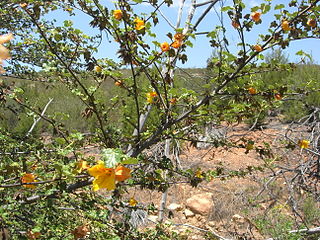
Fremontodendron mexicanum is a rare species of shrub in the mallow family known by the common names Mexican flannelbush, Mexican fremontia, and Southern flannelbush, that is endemic to the central Peninsular Ranges in Mexico and the United States.
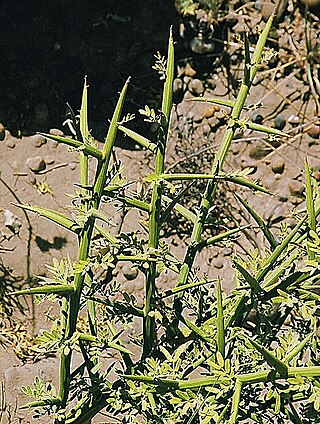
Prosopidastrum is a genus of flowering plants in the family Fabaceae. It includes seven species of shrubs native to the subtropical Americas, with six species native to Bolivia and Argentina, and one native to Baja California. They grow in subtropical xerophytic bushland, thicket, grassland, and semi-desert. It belongs to the mimosoid clade of the subfamily Caesalpinioideae.
Mexerion is a genus of flowering plants in the tribe Gnaphalieae within the family Asteraceae. As of May 2024, the number of species accepted varies from one to three.
Clinidium mexicanum is a species of ground beetle in the subfamily Rhysodinae. It was described by Louis Alexandre Auguste Chevrolat in 1873. It is endemic to the southern part of the Mexican Plateau. Clinidium mexicanum measure 6–8.5 mm (0.24–0.33 in) in length.

Galium mexicanum, the Mexican bedstraw, is a species of plant in the family Rubiaceae. It has a widespread distribution from British Columbia south to Ecuador.

The Otay Mountain Wilderness is a U.S. Wilderness Area located in San Diego County, California, 12 miles east of the community of Otay Mesa and just north of the Mexican border. Some parts of the wilderness area rise quickly from sea level, reaching a peak of just over 3,500 feet (1,100 m) at the summit of Otay Mountain.
Zuphioides longicolle is a species in the beetle family Carabidae. It is found in the United States and Mexico.
Bembidion mexicanum is a species of ground beetle in the family Carabidae. It is found in North America.
Maianthemum mexicanum is a perennial, terrestrial herb found as an understory species in moist forests. It is endemic to west-central Mexico.

Astrocaryum mexicanum, the chocho palm, cohune palm, or chapay, is a species of cocosoid palm in the family Arecaceae, native to Mexico and Central America. It is very long-lived for a palm, reaching 140 years. Local people harvest its young inflorescences, its seeds, and its hearts for food. Covered with stout spines, it is hardy to USDA zone 10a, and is occasionally planted as an ornamental in places such as Hawaii and Southern California.
Chrysophyllum mexicanum is a plant in the family Sapotaceae, native to Mexico and Central America.

Zuphioides is a genus of in the beetle family Carabidae. There are more than 20 described species in Zuphioides, found in North, Central, and South America.














